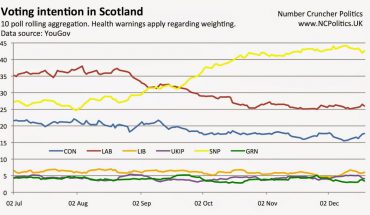It seems every successive election these days is dubbed "the social media election" and there is plenty of truth in that. All parties and their supporters are (obviously) getting in on the act in a variety of ways. But the most effective way to harness the power of social media is for your material to go viral, i.e. to have its reach increase exponentially as people share it with multiple others.
The problem from the point of view of most parties is that it's more common for content that is satirical (or downright scathing) to go viral – witness the Cameron speech mashup and Clegg apology. It’s much easier for parties that aren’t seen as part of the ‘uncool’ establishment, to get viral traction.
I follow all of the party leaders on Twitter and I noticed that Natalie Bennett and the (England and Wales) Greens are tweeting a follower count for each thousand new followers. Since tweets are dated, this gives us a series of data points to plot. And no, I did not trawl their entire feed, I have software to do that for me!
I would love to see the same data for the other parties and in particular UKIP and the SNP (the other two besides the Green parties whose memberships are growing) but I don’t have it at the moment. If anyone can provide data for one or more parties, or local divisions thereof, I’d be delighted to take a look. For now, here is the graph of the Greens’ followers:
It’s a pretty smooth curve. The jump at the beginning of last week corresponded to start of the debate about TV debates, but what’s interesting is that it’s not very noticeable – the growth rate of their Twitter following was increasing well before this. In early October it was more than 3 times the rate in August; after the debate announcement it tripled again. This pattern is consistent with viral content.
The surge in followers seems to be mirrored in membership, which is nudging 30,000 UK-wide. Whether these trends will be reflected in votes is another question, but the polls are also showing some signs of movement. This week’s 8% with Lord Ashcroft and 7% with YouGov might have been in the top half of the margin of error, but levels not exceeded since the 1980s are noteworthy nevertheless.



